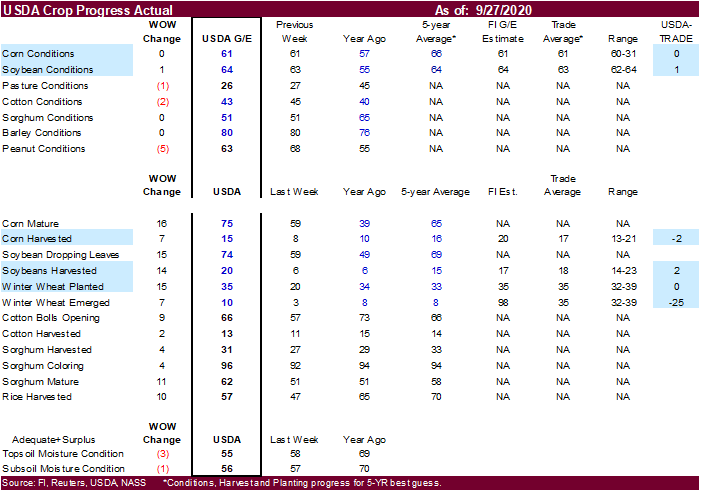PDF Attached
USD
was down 37 by 2:30 PM CT, WTI up $0.34, gold $20.20 higher and US equities higher. Lower trade for soybeans and meal, mainly positioning, while wheat corn and soybean oil were higher.

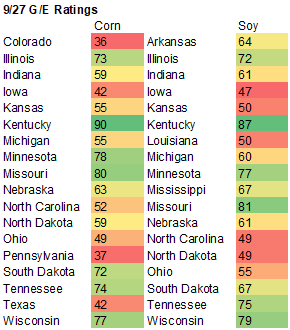
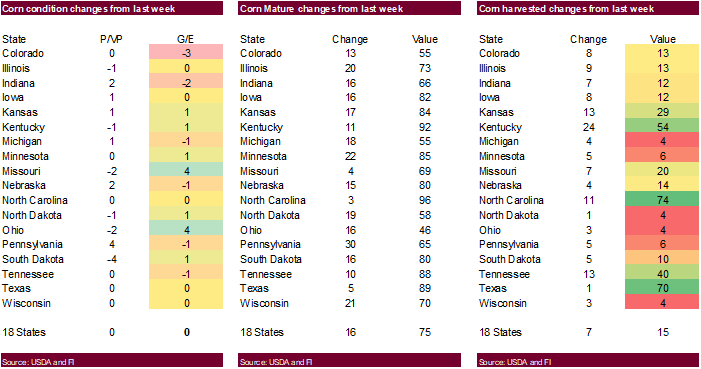
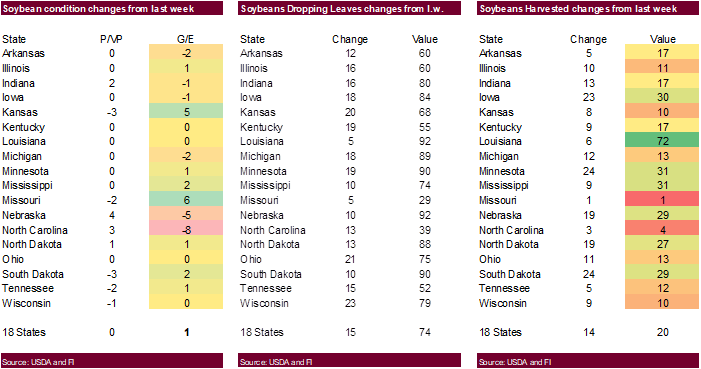
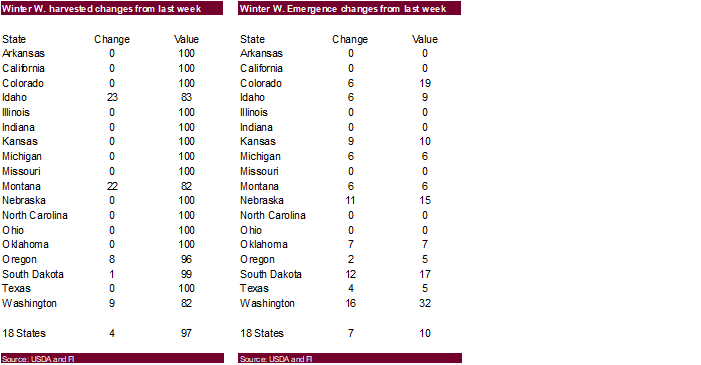
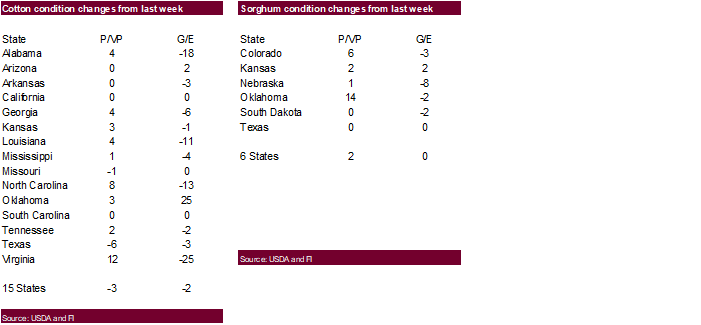
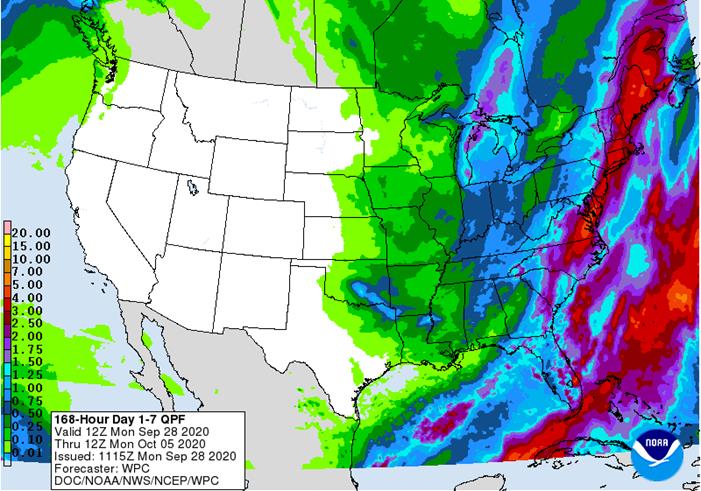
MOST
IMPORTANT WEATHER TO WATCH
- AREAS
OF CONCERN - U.S.
hard red winter wheat areas will be dry for the next ten days to two weeks and excessive heat and dryness has already depleted soil moisture - Montana
and South Dakota wheat areas need greater moisture too - Russia’s
Southern Region remains too dry for winter crop planting, although some brief showers will occur near the Ukrainian border over the coming week - Kazakhstan
wheat areas are still critically dry in unirrigated areas and rain is unlikely for the next two weeks - Northeastern
China continues to receive rain too frequently and summer crop maturation and harvesting remain slow, despite some weekend drying - South
Africa winter crop areas need rain as do future spring planting areas - Brazil’s
center west and center south crop areas will be dry into the middle of October further delaying the planting of early soybeans and some corn - Brazil
coffee areas will experience little to no rain of significance for the next ten days and possibly out two weeks - Brazil
temperatures will remain very warm to hot over the next ten days - Northwestern
and west-central Argentina will remain too dry over the next ten days - Flooding
rain may impact a part of far southern Mexico and Central America in the next ten days to two weeks - A
tropical cyclone may form in the Caribbean Sea later this week - Frost
and freezes occurred in a part of eastern Australia Sunday and today - AREAS
OF IMPROVEMENT - Southern
Argentina received significant weekend rain easing dryness and improving crop and field working potentials - Rain
fell in much of Europe easing long term dryness in several areas and more is expected - Ukraine
has received some rain and more will fall over the coming week to improve winter crop planting and establishment conditions - Net
drying is expected later this week in the U.S. Delta and southeastern states benefiting areas that have been too wet in recent weeks - Frost
and a few light freezes in eastern Australia wheat, barley and canola areas Sunday and today likely had low impact on the majority of crops, but an assessment of the impact will be needed - Most
lows were in the 30s and lower 40s Fahrenheit and some of the crop in New South Wales was in a sensitive state of development - World
Weather, Inc. anticipates a very low impact, but some negative impact cannot be ruled out of a few areas - Argentina
received some much needed rain late last week and during the weekend easing long term dryness in the south, but the north was left hot and dry - Rainfall
of 1.50 to 4.63 inches occurred Thursday through dawn today from a part of northern La Pampa and southeastern Cordoba to northern and central Buenos Aires, including southernmost Santa Fe and southernmost Entre Rios.
- Rainfall
farther south in southern Buenos Aires varied from 0.50 to 1.50 inches except near the coast of Buenos Aires east of Bahia Blanca where 0.35 to 0.50 inch resulted - The
rain was excellent in bolstering soil moisture for much improved wheat and barley development and improved early season corn and sunseed planting potentials - Northern
Argentina reported very little rain and was warm to hot temperatures with extreme highs in the 90s to 110 degrees Fahrenheit - The
heat accelerated drying and raised the need for significant rain in cotton, corn, sunseed and other crop areas - Argentina
rainfall over the next couple of weeks will favor the northeast part of the nation, although some other areas will get a few showers - Resulting
rainfall will not be very great in central, southern or western areas and more moisture will be needed
- Drought
will remain a serious concern in central and northern Cordoba, Santiago del Estero, parts of Santa Fe and neighboring areas - October
7-8 is the earliest opportunity for follow up rain in the previously driest areas in central and southern parts of the nation - Brazil
weekend temperatures were hot in the central and west with extreme highs in the 90s to 108 degrees Fahrenheit - Most
of the nation was dry except in central and southern Rio Grande do Sul where 0.15 to 1.10 inches resulting - Southern
corn and rice areas were wettest - Brazil
weather over the next ten days will be dry in the bulk of center west and center south production areas - Rain
will fall in northwestern Mato Grosso periodically and may benefit some early season soybean planting, but the bulk of the state will be left dry - Far
southern Brazil will continue to experience waves of rain during the next couple of weeks maintaining moisture abundance for reproducing and filling wheat and supporting early corn and rice planting and development - Some
wheat areas will be trending a little wet and need to dry down to protect crop quality - Europe
rainfall during the weekend increased as expected with precipitation noted from western Ukraine, Poland and parts of Romania west to France, far northern parts of Spain and Belgium - Sufficient
rain fell to improve soil moisture in many previously dry areas, but more rain is needed - Rain
is expected to fall additionally over the next ten days in most of Europe - France,
Belgium and the U.K. may experience heavy rainfall at times while Germany, western Poland and Czech Republic as well as the middle and lower Danube River Basin will receive the least amounts of rain - Planting
moisture will continue to increase - Some
dry time will be needed to promote autumn planting and summer crop harvesting - Ukraine
will get enough rain in the coming week to ten days to support planting of wheat, barley, rye and rapeseed - Improved
winter crop establishment is expected in those areas already planted - A
much improved winter crop production outlook will result, although more rain will be needed in October to ensure moisture deficits are significantly eased - Russia
weather over the next ten days will be drier biased except near the Baltic States, Belarus and Ukraine borders where some rain is expected - Showers
will also occur in the eastern New Lands - Net
drying is expected over most of the Volga River Basin, Ural Mountains region, Kazakhstan and Russia’s Southern Region - Good
harvest conditions will occur during this dry period and more autumn planting will take place, although the driest areas in southern areas will limit any new wheat and rye planting and emergence
- China
rain fell from Sichuan to Fujian and areas southwest into Indochina during the weekend - Moisture
totals were greatest from Sichuan to southern Jiangxi where 2.00 to 4.00 inches common and local totals to nearly 7.00 inches in Hunan - Net
drying occurred in other areas of China including east-central through northeastern areas - The
drying trend was welcome and beneficial, but it may be short-lived - Northeastern
China will be facing another week to ten days of frequent rainfall limiting summer crop maturation and harvest progress - Recent
drying was welcome, but returning rain, although not heavy, will prevent the region from drying out beneficially for aggressive fieldwork - A
more prolonged period of dry and warm weather is needed to get harvesting back on track after recent weeks of wet conditions - A
favorable mix of rain and sunshine will occur in the North China Plain and Yellow River Basin where good wheat planting and summer crop harvest progress is expected - Rain
will fall frequently in southern China maintaining wet conditions, but flood potentials should be low - Xinjiang
China weather contrasted greatly during the weekend with frost and freezes in the northeast where highs were limited to the upper 40s and lower 50s with very warm conditions elsewhere with peak temperatures reaching into the lower to middle 80s and lows in
the 50s Fahrenheit - Mostly
dry weather prevailed throughout the province - Xinjiang,
China weather this week will trend cooler farther to the south, but frost and freeze conditions will be limited to the northeast - The
cold is not a threat to cotton which has already been defoliated and the crop is being harvested - Rainfall
should be limited to spotty showers that will not harm fiber quality - Southeastern
Australia will experience waves of rain through the next two weeks benefiting long term wheat, barley and canola development - Queensland’s
greatest rain will occur next week - New
South Wales, Victoria and South Australia will be wettest and should have excellent long term crop prospects - Southern
portions of Western Australia will get some light rainfall early and again late this week, although moisture totals will not be more than 0.50 inch and the precipitation will not reach into northern crop areas - Greater
rain would be welcome, but sufficient amounts will occur to support favorable pre-reproductive crop development
- Northern
yield potentials may have slipped a little lower than usual, but losses are not dramatic - Australia’s
weekend rainfall varied from 0.05 to 0.50 inch in New South Wales, Victoria and southern parts of Western Australia - Several
local totals of 1.00 to 1.48 inches occurred from the southern border of New South Wales into Victoria - Queensland
was dry along with minor crop areas in northern and eastern parts of Western Australia and western parts of South Australia’s crop region - U.S.
weather provided no surprises during the weekend - Rain
was limited to the northern and western parts of the Midwest - Moisture
totals through Sunday varied from 0.05 to 0.73 inch from northern Missouri through eastern and southern Iowa to parts of Wisconsin - Greater
rain fell in upper Michigan where 1.00 to 2.00 inches of moisture resulted - Greater
rain also occurred from northeastern Kansas through west-central Missouri where 1.00 to 2.00 inches resulted
- A
trace to 0.25 inch and a few local totals to 0.50 inch occurred in the upper Midwest and northern Plains, although many of these areas did not receive much meaningful rain - Dry
conditions occurred in the central and eastern Midwest and Delta - Some
welcome drying occurred in the southeastern states after rain from remnants of Tropical Cyclone Beta passed through the region early in the weekend - Rainfall
of 1.00 to 3.60 inches occurred from coastal areas of Georgia to central Virginia from rain Friday into Saturday - Mostly
dry weather occurred in other U.S. crop areas - Temperatures
were very warm to hot Friday into Saturday in the central and southwestern Plains with extremes of 95 to 102 degrees Fahrenheit which is well above normal for this time of year - Temperatures
were more seasonable in many other areas - U.S.
weather outlook has not changed for the coming ten days - Temperatures
will be quite cool in the eastern half of the nation over this coming week with the cool conditions lingering a total of ten days - Waves
of light rain and drizzle will impact the Great Lakes region during much of the forecast period - Rain
in the lower eastern Midwest and Delta will occur today and a few other showers will occur periodically in other days this week and early next week in Indiana, Ohio and eastern Illinois as weak disturbances occur periodically
- Summer
crop harvesting will be very slow in the Great Lakes region - Summer
crop harvesting will be disrupted periodically in the lower eastern Midwest - Best
crop maturation and harvest weather is expected in the Great Plains and Delta during the next ten days - Dry
weather will also occur in the far western United States during much of the coming ten days with temperatures well above average - Very
little rain of significance will impact western hard red winter wheat areas where temperatures will be mild early this week and then rising above average later this week into next week - Low
soil moisture is expected in most of the high Plains region during the next ten days raising concern over early wheat establishment in unirrigated fields - West
Texas cotton, corn, sorghum and peanut areas will not be impacted by much precipitation over the next ten days which should protect cotton fiber quality and support normal maturation
- GFS
and European forecast model runs are suggesting tropical cyclone development in the Caribbean Sea next week that might eventually threaten the southeastern United States and/or Cuba, but this event is too far out in the forecast for much confidence - No
active tropical cyclones are present in the world today - Western
South Africa received a few showers during the weekend benefiting some of the winter crops in that region - Rain
also occurred in eastern Natal - South
Africa weekend temperatures were very warm to hot in Limpopo while frost and freezes occurred in Free State, North West and other western parts of the nation - India’s
weekend rain was greatest in the far Eastern States and Bangladesh as well as in the interior south while net drying occurred elsewhere - Some
flooding occurred in northern Bangladesh and neighboring areas of India - The
drier bias was ideal for inducing some crop maturation - Temperatures
were very warm to hot in the interior north and northwest - Pakistan
weather was also mostly dry and warm to hot during the weekend - India
rain will continue to withdraw from central areas over the coming week while periods of rain prevail in the far eastern and extreme southern parts of the nation during the next ten days - Summer
crop maturation and early harvest progress will advance favorably - Ontario
and Quebec, Canada may get rain a little more frequently than desired this week and lasting at least a week and possibly for ten days resulting in some crop maturation and harvest delays - West-central
Africa will continue to experience periodic showers and thunderstorms over the next couple of weeks - Cotton
areas will need to dry out soon to protect fiber quality and promote maturation - Most
coffee, cocoa, rice and sugarcane crops receiving rain will likely benefit from the moisture
- Weekend
rain was most significant in Ghana, eastern Nigeria and Cameroon - East
central Africa rainfall has been and will continue to be erratic and mostly beneficial over the next ten days - Mainland
areas of Southeast Asia will experience periodic showers and thunderstorms over the next couple of weeks
- Late
season moisture boosting is extremely important since water supply has not been fully restored from last year’s low levels - Philippines
rainfall will continue periodically benefiting most crops. - Improving
rainfall in Indonesia and Malaysia is expected over the next two weeks with some locally heavy rain possible in random locations especially in the first week of October -
New
Zealand rainfall will be erratic over the next two weeks while temperatures are cooler than usual -
Soil
moisture is rated favorably -
Mexico
precipitation is expected to be confined to the far south over the next week while all other areas experience net drying -
Frequent
rain will continue in Central America maintaining good crop conditions over the next two weeks -
A
few areas will get too much rain resulting in local flooding -
Southern
Oscillation Index was +10.63 today and it will stay significantly positive throughout this week
Source:
World Weather Inc.
- USDA
weekly corn, soybean, wheat export inspections, 11am - U.S.
crop conditions, harvesting progress for soybeans, corn, cotton, 4pm - FT
Commodities Global Summit (Sept. 28-30) - EU
weekly grain, oilseed import and export data - Ivory
Coast cocoa arrivals - EARNINGS:
Louis Dreyfus
TUESDAY,
Sept. 29:
- Nothing
major scheduled
WEDNESDAY,
Sept. 30:
- EIA
U.S. weekly ethanol inventories, production, 10:30am - USDA
quarterly corn, soybean, wheat, sorghum, barley and oat stocks - U.S.
wheat production for Sept. - Roundtable
on Sustainable Palm Oil virtual discussion on seasonal haze - Malaysia
Sept. 1-30 palm oil export data - U.S
agricultural prices paid, received for Aug., 3pm - Poland
to release grains output data - HOLIDAY:
Korea
THURSDAY,
Oct. 1:
- USDA
weekly crop net-export sales for corn, soybeans, wheat, cotton, pork, beef, 8:30am - Port
of Rouen data on French grain exports - USDA
soybean crush, DDGS output, corn for ethanol, 3pm - Australia
commodity index for Sept. - Webinar
on the effects of climate change on coffee production in Southeast Asia - Honduras,
Costa Rica coffee exports monthly stats - International
Cotton Advisory Committee releases monthly world outlook - HOLIDAY:
China, Hong Kong, Korea
FRIDAY,
Oct. 2:
- ICE
Futures Europe weekly commitments of traders report, 1:30pm (6:30pm London) - CFTC
commitments of traders weekly report on positions for various U.S. futures and options, 3:30pm - FranceAgriMer
weekly update on crop conditions - HOLIDAY:
China, Hong Kong, India, Korea
USDA
inspections versus Reuters trade range
Wheat
563,427 versus 400000-650000 range
Corn
806,639 versus 650000-900000 range
Soybeans
1,211,733 versus 1100000-1400000 range

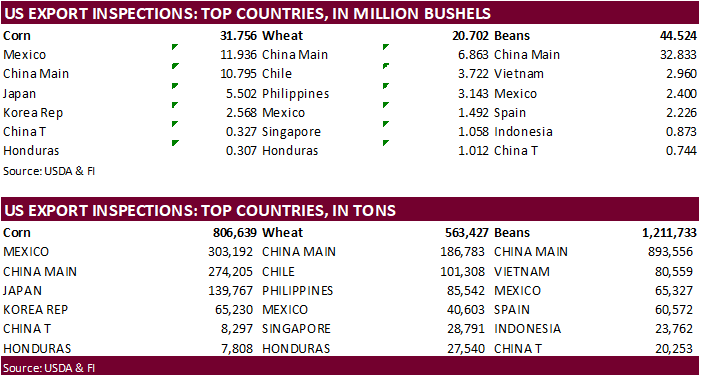
GRAINS
INSPECTED AND/OR WEIGHED FOR EXPORT
REPORTED IN WEEK ENDING SEP 24, 2020
— METRIC TONS —
————————————————————————-
CURRENT PREVIOUS
———–
WEEK ENDING ———- MARKET YEAR MARKET YEAR
GRAIN 09/24/2020 09/17/2020 09/26/2019 TO DATE TO DATE
BARLEY
0 0 2,595 5,727 5,631
CORN
806,639 765,589 421,735 2,783,261 1,552,263
FLAXSEED
0 0 0 389 72
MIXED
0 0 0 0 0
OATS
0 48 0 996 798
RYE
0 0 0 0 0
SORGHUM
58,243 71,501 15,383 304,108 101,058
SOYBEANS
1,211,733 1,379,971 986,305 4,848,745 3,154,539
SUNFLOWER
0 0 0 0 0
WHEAT
563,427 503,034 502,915 9,220,833 8,521,565
Total
2,640,042 2,720,143 1,928,933 17,164,059 13,335,926
CROP
MARKETING YEARS BEGIN JUNE 1 FOR WHEAT, RYE, OATS, BARLEY AND
FLAXSEED;
SEPTEMBER 1 FOR CORN, SORGHUM, SOYBEANS AND SUNFLOWER SEEDS.
INCLUDES
WATERWAY SHIPMENTS TO CANADA.
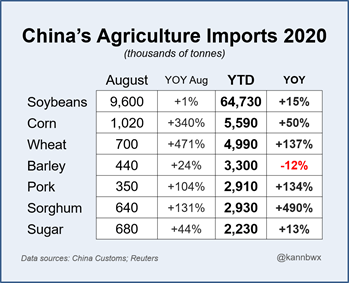
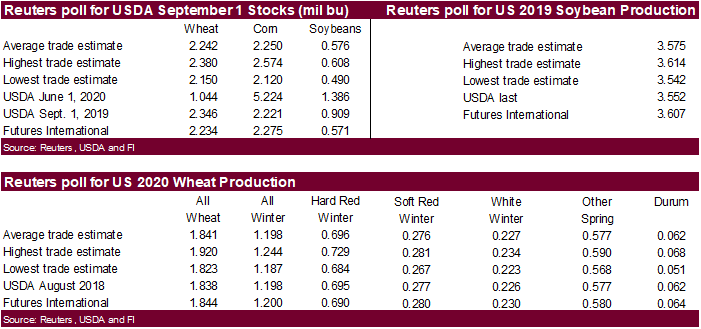
Note
Reuters polled for 2019 corn production. We think it will be unchanged. Reuters average was 13.607 billion bu versus 13.617 USDA, so others also not looking for change (range 13.427-13.750 billion for those looking for a change).
Average
estimates for 2019-20 ending stocks for September 1 don’t deviate much from USDA
USDA
Aug 2019-20 corn carry 2.253 (ave. est. 3 bushels below USDA)
USDA
Aug 2019-20 soy carry 0.575 (ave. est. 1 bushel above USDA)
Macros
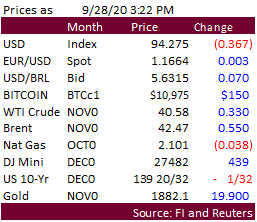
-
Corn
opened lower despite a lower USD. Selling started to dry up around 9:30 am and at 9:41 CT, 3,400 December corn contracts traded, and prices traded around unchanged. Prices increased following wheat and good export developments. December corn only ended
1.50 cents higher and March was up 2.25 cents. USDA posted corn sales to Japan and unknown destinations. Producers were busy selling soybeans but not so much for corn. China imported 5.59MMT of corn and 64.730 million tons of soybeans during Jan and Aug.
We look for Chinese corn imports to remain steady through the end of 2020. US CIF corn basis was firm on Monday. Friday’s USDA US hog inventory report was viewed as friendly for corn but for the second quarter in a row, USDA showed a contraction in the breeding
herd in response to low prices, a signal the industry may contract over the medium term. Note cold storage stocks of pork as of Aug 31 were up 2 percent from July but remain 23 percent below a year ago, thanks to an industry slowdown in slaughter due to COVID-19
earlier this year.
-
Funds
bought an estimated net 8,000 corn contracts.
-
USDA
US corn export inspections as of September 24, 2020 were 806,639 tons, within a range of trade expectations, above 765,589 tons previous week and compares to 421,735 tons year ago. Major countries included Mexico for 303,192 tons, China Main for 274,205 tons,
and Japan for 139,767 tons. -
Look
for volatility ahead of the September 30 Grains Stocks report as we near an end to the month and quarter.
-
Argentina
saw welcome rains over the weekend. France as well. -
China
starts their weeklong holiday on Thursday so we will see if they visit the US market before then.
-
US
corn harvest progress was active over the weekend and may slow this week across the Great Lakes region where rain will occur. USDA reported 15 percent of the corn crop collected, up from 8 percent last week and compares to 10 percent year ago and 16 percent
average. Traders were looking for 17 percent. 75 percent of the corn crop is mature, 10 points above year ago.
-
US
corn conditions were reported at 61 percent, unchanged from the previous week. Traders were looking for unchanged.
-
Germany
ASF: 2 additional cases reported over the weekend – 36 cases since September 10
Argentina
poultry and products annual
Franken,
J. “Many Market Ready Hogs with Industry Contraction to Follow.” farmdoc daily (10):173, Department of Agricultural and Consumer Economics, University of Illinois at Urbana-Champaign, September 28, 2020.
Corn
Export Developments
-
Iran
seeks 200,000 tons of corn feed and 200,000 tons of soybean meal on Sep 30 for OND shipment. The corn will be out of the Black or EU or South America.
-
Under
the 24-hour reporting system, US exporters reported the following: -
Export
sales of 207,140 tons of corn received during the reporting period for delivery to unknown destinations during the 2020/2021 marketing year -
Export
sales of 110,800 tons of corn for delivery to Japan during the 2020/2021 marketing year
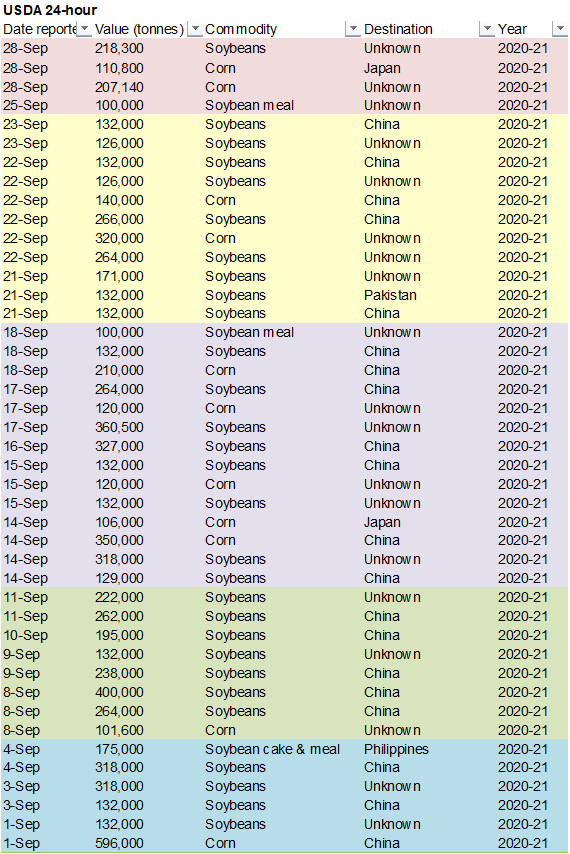
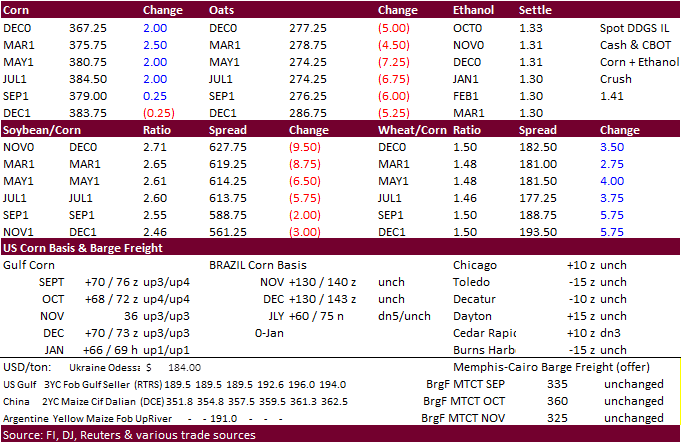
Updated
9/9/20
-
December
is seen in a $3.40-$3.85 range. 2020-21 to average $3.75 for corn and $2.85 for oats.

